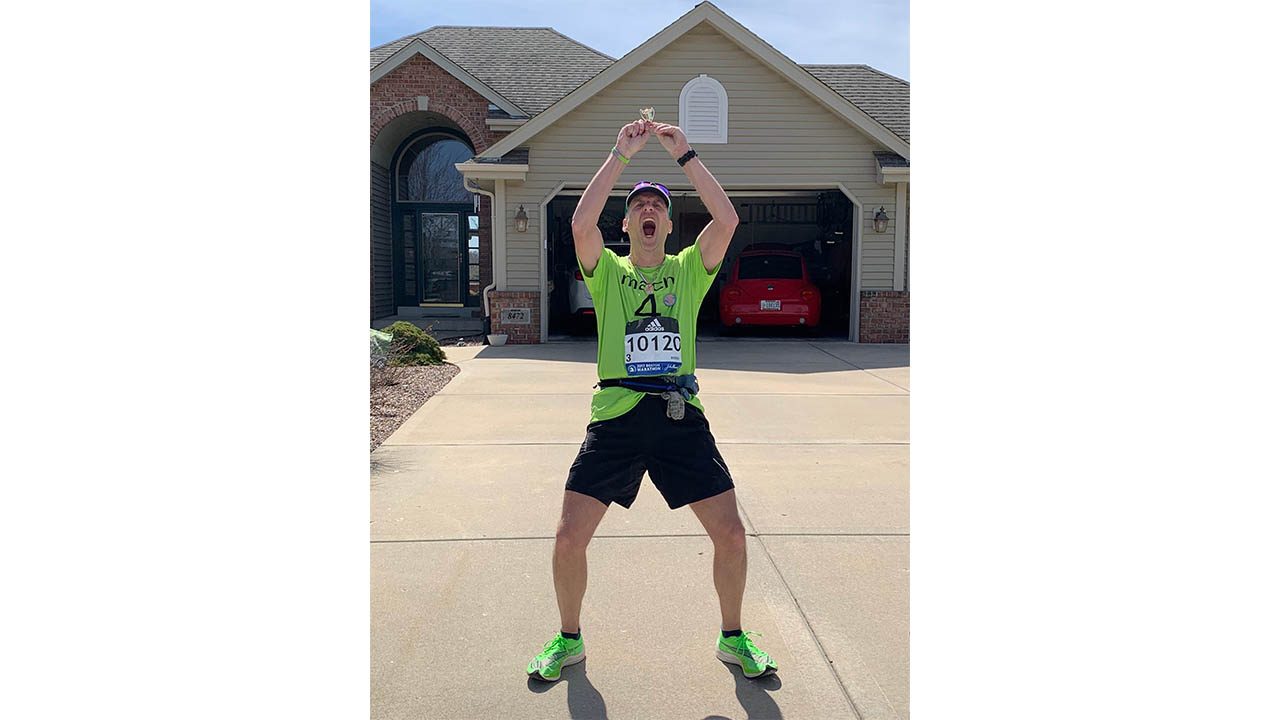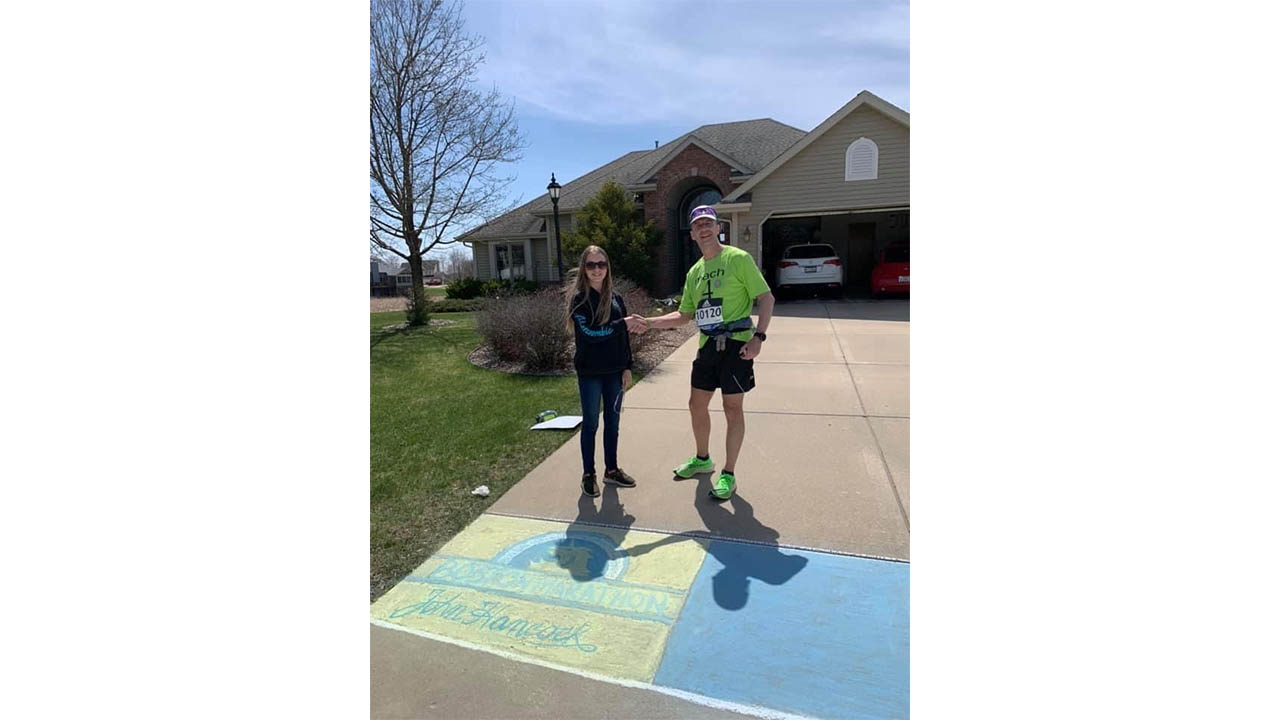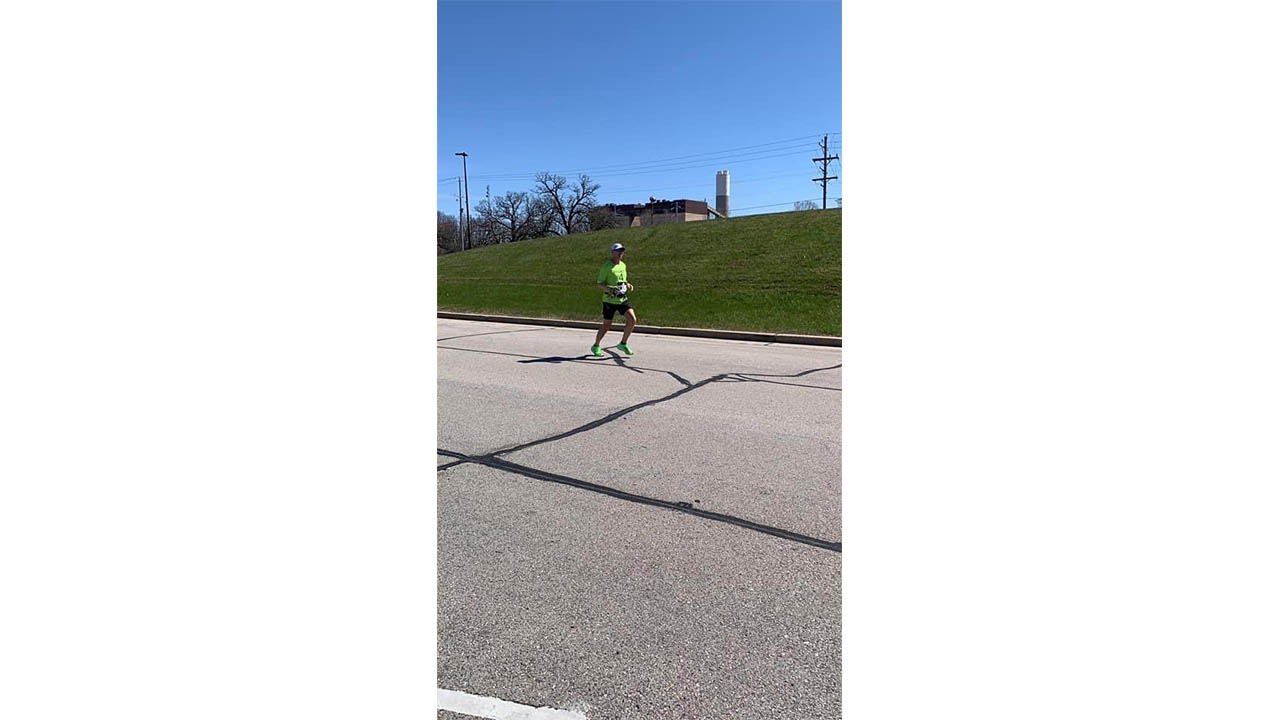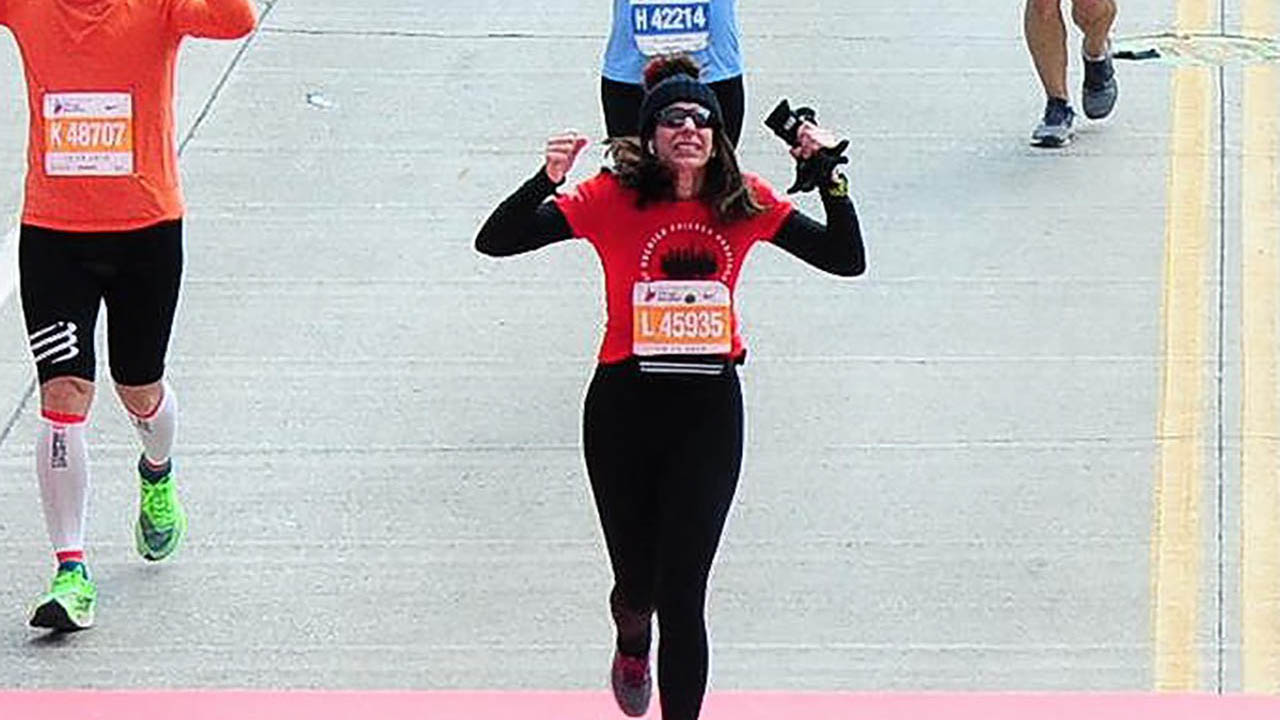
Sprinting to Save a Marathon: Professional Event Manager Comes Up with Ultimate DIY Plan
COVID-19 may have forced the human race to adapt its lifestyle, but it hasn’t stopped people from living their lives – or running races. It hasn’t broken our spirits or stopped us from sprinting across marathon finish lines, either.
If anything, this virus’ sudden surge has bolstered our creativity and helped us truly appreciate the things that matter most in life: family, community, health and (of course) doughnuts!
Joe Zons reminded us of that when he re-created the Boston Marathon in his hometown of Pleasant Prairie, Wisconsin, complete with an award ceremony and all.
Living the (Rugged) Runner’s Life: The Joe Zons Story
When Boston Marathon organizers made the call to postpone the world-renowned event on March 13, 2020, Joe – who was out training to run that very race – could have called it a day and ran right to his couch to relax. He didn’t need to keep logging miles, nor did he have any reason to keep up his strict regimen. As Senior Manager of Events Management at Zebra Technologies, Joe knew it was likely going to be several months before any large-scale race would have the all-clear to proceed. Plus, this year would have marked his seventh Boston Marathon and 23rd marathon in total. When it was safe for him to travel and compete in a crowd again, he could restart his training without a problem. He is a pro.
Then again, he is also a pro at organizing events.
So, instead of letting all those months of preparation go to waste, Joe did exactly what anyone in his shoes and with his experience would do: he went straight to work (on his cozy couch) planning what would turn out to be an even more epic marathon.
What transpired over the next few weeks will completely inspire you. Maybe not to run a marathon on your own, in the middle of summer, in the middle of nowhere...but perhaps to recreate a vacation that was postponed. Or, at the very least, to run a few blocks to get doughnuts to share with your family as you celebrate summer with your neighbors during a socially-distant driveway “block party.”
Then again, once you hear about how Joe managed to re-create nearly every detail of the iconic Boston Marathon race day experience more than 1,000 miles from Boston in a month’s time before running the 26.2 miles by himself in near-record time, you might be motivated enough to proclaim a DIY marathon as #MyPandemicSurvivalPlan or, at the very least, a #HealthyAtHome goal! Keep reading below to learn how Joe managed to pull off his DIY marathon alongside his busy schedule managing (now virtual) events for Zebra…
Your Edge Blog Team: Tell us a little bit about your job as Senior Manager Events Management at Zebra. What was it like prior to the COVID-19 outbreak and how has it changed since?
Joe: Before COVID-19 came on the scene, my team was focused on executing the quite-heavy lineup of in-person events that Zebra was scheduled to participate in around North America. In addition to working on the overall event strategy for 2020 events, including booth layouts, technology demos, audio/visual setups, and production sets, we were also starting to develop our long-range events calendars (looking out to 2024). With almost every in-person event between March and December 2020 now canceled or transitioned to a virtual-only format, the team has been able to really dig into our overall corporate event strategy to assess its impact to-date and refine as needed. We have also been able to commit more resources than usual to long-range planning efforts and understanding what it means to host or participate in completely “virtual” events. With all of the challenges that COVID-19 has presented, our silver lining has come from the fact that our team has stayed busy and learned many best practices that will ensure Zebra is well-positioned to maximize its event participation moving forward, regardless of the format.
Your Edge Blog Team: We imagine that preparing for a marathon – and certainly planning a marathon – must take a lot of time and dedication. How did you find the time, first off, to train for a marathon while working full time? And how did you ultimately manage to plan a marathon, while working and still training to run that marathon?
Joe: Planning for the DIY marathon was fairly easy. I just took a couple of hours to scope out a safe route, along with finding a spot on the route to hide some in-race hydration. I also made sure to have my race-day outfit all ready to go. Once that was done, I was all set.
And I’ve trained for a marathon 23 times now, so I have my routine, if you can call it that. The truth is that, with a family at home and the demands of the job (and the travel prior to COVID-19), it is always difficult to find the time to train. I have just learned to be flexible – sometimes that means a weekday run at 4:30 a.m. or 9 p.m., or a weekend run at 3 a.m. to beat the heat. When on the road, the opportunity to run in new cities is always a treat. As an example, while in New York City for the National Retail Foundation (NRF) Big Show in January, I was able to do a couple of early morning runs through Central Park. That was cool. If the weather does not cooperate, the treadmill is always a good fallback option, but so terribly boring, in my opinion.
Your Edge Blog Team: So, what you’re saying is that anyone could plan a DIY marathon in their spare time if so inspired?
Joe: Absolutely! Of course, actually running a marathon does require a greater time commitment over a longer period just given the training needed to build up your endurance. However, it’s still not more than an hour or two a day, and maybe a touch longer on weekends.
Your Edge Blog Team: Since the Boston Marathon was the event that you were training for when COVID-19 outbreak began, was that the sole inspiration for your DIY marathon? Or did you also pull in elements from your other past marathon experiences?
Joe: The Boston Marathon was truly my inspiration for this DIY marathon. I had completed 22 marathons previously, so running “another marathon” is just something I don’t need to do. That’s why I made sure that this one was done on the same day as the originally scheduled race (Monday, April 20th) at the same starting time (10:25 a.m.). I even played the “Star Spangled Banner” on my cell phone at the starting line and kicked off the race with the same siren they would have used. I also decided to wear a bib from a previous Boston Marathon – the 2017 event, which I missed due to injury – and eat my signature pre-game peanut butter and jelly sandwich to make this as authentic as possible.
Your Edge Blog Team: What would you change about the event, if anything, if you were to “host” another marathon in the future?
Joe: If I do this again, I will probably ask others to run along with me. At the time of the race, we were right in the middle of the peak of the first COVID-19 wave in my community, and I was being extra cautious of being around other people and vice versa. It would have been cool to have someone run with me, either for the whole race or at least a portion of the run.
Your Edge Blog Team: Even running solo, though, you still managed to clock your second-best marathon time. Did you find this achievement to be bittersweet, considering the circumstances?
Joe: The intent of the race that day was to complete the course in a time that, theoretically, would have been a Boston qualifier. A male in my age bracket needs a time in under three hours and 25 minutes, so that was the goal. The fact that I ran a 3:16:29 was icing on the cake and not bittersweet at all. There are a lot of factors that go into producing a fast time on race day, namely the weather – which for me was close to ideal that day. Hopefully my next “real” marathon will have the planets all in alignment again and I can nail a personal record (PR)!
Your Edge Blog Team: Crossing the marathon finish line in your driveway probably felt much different from crossing it in Boston along with other runners, right? Did you find your finish to be more enjoyable this time around, surrounded by friends and family (and greeted with doughnuts)?
Joe: I would have to say that this experience was at the top of the list for me when it comes to marathons. Yes, I have run faster and farther (I have done two 50-mile ultramarathons), but the significance of the day, with friends and family around, during the middle of a pandemic, and getting “first place” at the Boston Marathon was awesome. The fact that my overachieving running buddies drew the iconic Boston Marathon finish line across my driveway and my daughter presented me with a first-place medal and trophy put the experience over the top as the best “Boston” ever!

Your Edge Blog Team: Even though you had so much fanfare and support throughout this journey, how much more difficult was it to find the motivation to run 26.2 miles without the factors of the crowds and other runners?
Joe: I am one of those runners who does not listen to music when I run and use my own internal thoughts to keep me going during any run or race. I do, however, like to feed off the crowd during a race, especially Boston with its one million+ spectators on race day. That was certainly missing during my DIY marathon. The groups of farm animals I passed along the way just weren’t as spirited as I’d hoped they would be. But, in all seriousness, since the run was going so well for me that day physically, the emotional boost that the crowd would give me was less of a factor than it normally would be.

Your Edge Blog Team: That’s incredible! So, now that you’ve completed your first-ever “virtual” Boston Marathon solo in near-record time, what are your next running goals?
Joe: Most of my marathon goals have been achieved, but I would like to break 3:10 for the marathon and seven hours for a 50-mile ultramarathon.
Your Edge Blog Team: It sounds like you won’t be slowing down any time soon, then! Are you able to balance training and work with other personal passions?
Joe: Outside of running, I do enjoy golfing, biking and spending time with my kids. We recently got our first dog and, though he is a lot of work, has been a great addition to the family!
Your Edge Blog Team: Before we let you go, do you have any tips for those who may want to take up running?
Joe: I have a couple of tips for those who are new to running. First, go to a running specialty store to get the right shoes for your body type and running style. Then, take a slow approach to running. Maybe start out with a mixture of walking and running. Both of these will help to prevent injuries and keep discouragement from creeping into the picture. And as always, consult your physician if you have any medical conditions that may be in play with regular exercise.
###
A Final Thought
Joe is certainly a superstar! But, remember, he’s not superhuman. He’s just like you and me, doing our best to navigate the current circumstances of the world. Even if Joe’s story didn’t compel you to lace up your shoes and go for a run right now, there is still something to be learned from his attitude, agility and innovation.
We can wait on the world to change, or we can change the way we see the world. If we choose the latter, we will find it far easier to cross the many finish lines we are running toward each day in the marathon of life. We may feel like we’re missing out on things because of COVID-19, but the truth is that we don’t have to miss out any anything. We just have to rethink the way we vacation, celebrate birthdays, get married or run marathons. And as Joe proved, with a little imagination, we can make life’s big events just as joyous and memorable as the “real thing” – if not more so. We can also help preserve the little things in life that significantly boost people’s happiness and well-being.
In fact, that’s exactly what Joe’s Zebra colleague and fellow runner, Lisa Cowgill, has been trying to do since March.
You see, the runners weren’t the only ones impacted by the Boston Marathon’s cancellation. Many non-profits rely on participants’ fundraising ahead of the race to sustain their charitable missions and provide community support for the rest of the year. House of Possibilities (HOPe) is one of them.
Based in Easton, MA, House of Possibilities strives to make a difference in the lives of children, adults and families living with developmental challenges by providing high-quality programs and much needed relief and hope. For example, it hosts programs such as Adventure Club, Brunch Bunch and Hopemakers in order to promote children’s social growth, independence and a sense of belonging. It also offers a weekend overnight respite program that gives parents a chance to reset and recharge. But, when the COVID-19 outbreak started (forcing the organization to close its front doors) HOPe’s programs, and its members, were severely impacted.
Knowing how HOPe’s fully inclusive, positive environment can benefit children and their families, Lisa kept training for the Boston Marathon as part of Team HOPe in order to keep fundraising for the organization. Even though she had technically already met her $15,000 goal, she didn’t know if she’d have an opportunity to run the Boston Marathon course in 2020 due to the COVID-19 pandemic.
All she did know was that HOPe needed financial help transitioning its programs to a virtual-only setting and that any additional money she could raise would go a long way to protecting the well-being of families like hers. Lisa’s son and daughter both have ADHD, and her son has high-functioning Autism. HOPe gives members the opportunity to practice their social skills with fellow peers and adults who understand how to best support them. “The continual practicing of social skills with peers amplifies their abilities and gives us hope for what's to come in the future,” she explains.

So, she continues to run (and fundraise) in the hope that she will be able to give back to an organization that has given support and hope to so many families. She wants to ensure House of Possibilities can continue to nurture each child’s gifts and talents, give them the resources they need to discover their purpose and path in life, help them to reach their full potential and utilize those gifts and talents in a positive way as adults.
Though Lisa currently plans to meet up with other Team HOPe runners in Boston in September, she knows current COVID-19 conditions could change, keeping her closer to home. If that happens, she’ll run the 26.2 miles in her current hometown of Chicago, knowing that every step she takes toward the finish line gets HOPe one step closer to improving the well-being of another child or family.
So, each day when you wake up, lace up those theoretical shoes and just keep putting one foot in front of the other until you reach your finish line. When you encounter what seems like an obstacle, make a pit stop on your couch and think, “what would Joe do?” or “what small action can I take today in order to help someone else find a little joy?” Then get to work creating your master DIY plan. That is how you will “win” whatever race you’re running, despite any odds that may seem to be against you.

Editor’s Note:
If you would like to join Lisa in supporting House of Possibilities (HOPe) and its members during the COVID-19 crisis, you can make a donation here. Although her fundraising goal has been met, Team HOPe’s work is far from done. They have not yet crossed the finish line, as resource demands continue to grow amidst the COVID-19 crisis. Lisa and other members of Team HOPe want to ensure the organization can sustain its mission indefinitely.


Zebra’s “Your Edge” Blog Team
The “Your Edge” Blog Team is comprised of content curators and editors from Zebra’s Global PR, Thought Leadership and Advocacy team. Our goal is to connect you with the industry experts best-versed on the issues, trends and solutions that impact your business. We will collectively deliver critical news analysis, exclusive insights on the state of your industry, and guidance on how your organization can leverage a number of different proven technology platforms and strategies to capture your edge.




